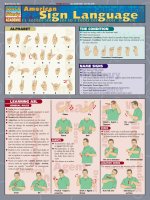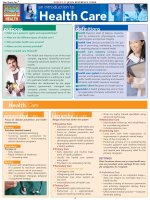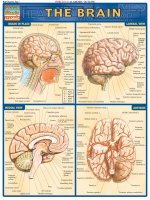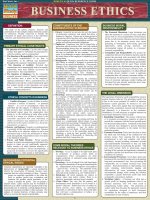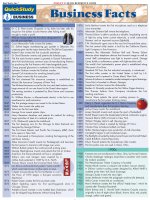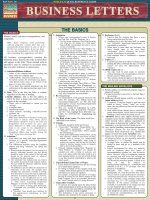BarCharts quickstudy nursing
Bạn đang xem bản rút gọn của tài liệu. Xem và tải ngay bản đầy đủ của tài liệu tại đây (863.88 KB, 4 trang )
BarCharts, Inc.®
WORLD’S #1 ACADEMIC OUTLINE
ADVENTITIOUS LUNG SOUNDS
ASSESSING LUNG SOUNDS
To auscultate lung sounds, move the diaphragm of your stethoscope
according to the numbers on the corresponding diagram.
There are three normal breath sounds.
(B) Bronchial breath sounds-loud, harsh, high pitched.
Heard over trachea, bronchi (between clavicles and midsternum), and over main bronchus.
(BV) Bronchovesicular breath sounds-blowing sounds, moderate intensity and pitch.
SOUND
CHARACTERISTICS
LUNG PROBLEM
Crackles
popping, crackling,
bubbling, moist sounds
on inspiration
pneumonia, pulmonary
edema, pulmonary fibrosis
Rhonchi
rumbling sound on
expiration
pneumonia, emphysema,
bronchitis, bronchiectasis
Wheezes
high-pitched musical
sound during both
inspiration and
expiration (louder)
emphysema, asthma,
foreign bodies
Heard over large airways, on either side of sternum, at the Angle of Louis, and between scapulae.
(V) Vesicular breath sounds-soft breezy quality, low pitched.
Heard over the peripheral lung area, heard best at base of lungs.
B
V
1
2
V
2
V
3 BV
BV
3
4
4
5
5
6
6
7
7
ARTERIAL BLOOD GAS ANALYSIS (ABGS)
V
4
4
V
5
5
V
V
V
V
V
9
NORMAL EKG PATTERN
COMPLEX
NORMAL LENGTH OF TIME
WHAT IT REPRESENTS
P wave
<.12 sec
depolarization of atriapreparation for contraction
.12 to .2 sec
time for impulse to spread
from atria to ventricles
0.04 to 0.11 sec
depolarization of the ventricles
-0.5 and +1.0 mm
below and above the baseline
completion of ventricular depolarization
ST segment
QT interval
up to 0.43 sec
electrical systole
T wave
<5 mm in amplitude
repolarization of ventricles
sometimes follows T wave
may indicate hypokalemia
U wave
1 second
R
T
P
1.0 millivolt (mV)
0.5 mV
U
S
QRS
complex
0.1mV
Q-T
interval
CARDIAC ENZYMES
LDH2
SGOT, AST
Aspartate
aminotransferase
Faint; heard after nurse has concentrated
Faint murmur heard immediately
Moderately loud, not associated with thrill
Loud and may be associated with a thrill
Very loud; associated with thrill
Very loud; heard with stethoscope off chest, associated with thrill
1.The systolic phase begins with the first heart sound (S1), the closure of the mitral
and tricuspid (AV) valves.
2.The diastolic phase begins with the second heart sound (S2), the closure of the aortic and pulmonic (semilunar) valves.
Q
LDH1
Lactic
dehydrogenase
GRADING OF HEART MURMURS
Grade I
Grade II
Grade III
Grade IV
Grade V
Grade VI
Heart sounds produced by valve closure are best heard where blood flows
away from the valve instead of directly over the valve. The white circled
areas on the corresponding diagram indicate optimal placement of
the stethoscope for auscultating heart sounds.
S-T
segment
CK-MB
Creatine kinasemyocardial muscle
A quick method of analysis:
Look at the pH first. Draw an arrow if it is low or high. An arrow indicating
low (↓) means acidosis. An arrow indicating high (↑) means alkalosis. Next,
look at the respiratory indicator (PaCO2). Draw an arrow if it is low or high.
Interpretation: If the arrows are in the opposite direction, the problem is respiratory in nature-either resp. acidosis or resp. alkalosis. Next, look at the metabolic indicator (HCO3). Draw an arrow if it is low or high.
Interpretation: If the pH arrow and the metabolic arrow are in the same direction, the
problem is of metabolic in nature-either metab. acidosis or metab. alkalosis.
Additional analysis: Compensation is present if the arrows of PaCO2 and
HCO3 are opposite. Partial compensation is present if the arrows of PaCO2 and
HCO3 point in the same direction.
HEART SOUNDS
1 mm
(0.04 second)
ENZYME
7.35 to 7.45
35 to 45 mm Hq
22-26 mEq/L
5 mm
(0.2 second)
P-R
segment
P-R
interval
pH
PaCO2
HCO3
V
8
8
9
PR
interval
QRS
complex
pleurisy, pneumonia,
pleural infarct
BV
V
3
V
V
3
V
V
BV
Pleural Friction
dry, grating sound on
Rub
both inspiration and expiration
2
2
V
BV
1
1
V
B
B
1
OCCURS
AFTER ACUTE
ISCHEMIC EVENT
PEAKS
0-7 U/L
>0.05
fraction of total CK
4 to 6 hrs
18 to 24 hrs
29-37%
0.15 to 0.40
fraction of total
48 hrs
4 to 6 days
42-48%
0.20 to 0.45
fraction of the total
48 hrs
4 to 6 days
7 to 27 U/L
8 to 12 hrs
48 hrs
NORMAL
CRANIAL NERVES (CN)
CRANIAL NERVE
TYPE
FUNCTION
I
Olfactory
sensory
smell
II
Optic
sensory
III
Oculomotor
motor
parasympathetic
IV
V
VI
SYMPTOM ANALYSIS
ASSESSMENT
identify familiar odors with
each nare separately
vision
Snellen chart, examine ocular
fundus with ophthalmoscope,
assess light reflex
extraocular eye movement, assess EOM with 6 cardinal
elevation of eyelid
positions of gaze
pupil constriction
cover/uncover test
assess constriction with light
extraocular eye movement
same as CN III
somatic sensations of
palpate temporal and
cornea and face
masseter muscles teeth clenched
Trochlear
Trigeminal
Ophthalmic
branch
motor
sensory
Maxillary
branch
sensory
somatic sensations of face,
test corneal reflex, touch
oral cavity, anterior 2/3 forehead, cheeks, and chin with
of tongue, teeth
cotton wisp
Mandibular
branch
sensory
somatic sensation lower face
symmetrical comparisons
motor
motor
mastication
lateral eye movement
bite down or chew
look to ‘right and left’
motor
facial expression
smile, frown, puff cheeks
Abducens
VII Facial
sensory
taste, anterior 2/3 of tongue
identify taste
parasympathetic
salivation
assess for saliva
sensory
equilibrium
observe balance
When assessing a client’s problem, remember all these areas to help
the client describe the problem fully. Using the mnemonic device,
PQRST, a systematic and thorough assessment is possible by considering all of the following areas.
P Provocative/Palliative
What causes it? What makes it better? What makes it worse?
Q Quality/Quantity
How does it feel, look, or sound, and how much of it is there?
R Region/Radiation
Where is it? Does it spread?
S Severity Scale
Does it interfere with ADL? How does it rate on a severity scale of 1 to 10?
T Timing
When did it begin? How often does it occur? Is it sudden or gradual?
How long does an episode of the symptom last?
GLASGOW COMA SCALE (GCS)
A neurologic assessment scale that provides objective measurement of
level of consciousness, pupil reaction, and motor activity. The total of the
three scores can range from 3 to 15. A client who is oriented, opens the
eyes spontaneously, and follows commands scores a 15. A client in a deep
coma would score a 3. The first GCS score becomes the baseline. Future
scores indicate trends or changes in neurologic status.
MEASURE
Eye response
VIII Vestibular
IX
Cochlear
Glossopharyngeal
sensory
sensory
motor
X
Vagus
XI
Spinal
accessory
XII Hypoglossal
hearing
hearing acuity, Weber & Rinne test
taste, post. 1/3 of tongue,
identifies taste
pharyngeal sensation
swallowing
test gag reflex, use tongue
blade, note rise of uvula
with “ahhh”
sensory
sensation in pharynx, larynx,
and external ear
test same as CN IX
motor
swallowing
test same as CN IX
parasympathetic
motor
thoracic and abdominal
visceral activity
neck and shoulder movement
motor
tongue movement
draw pencil line
toward umbilicus
push chin against hand,
shrug shoulder
move tongue side to side
against a tongue depressor
INSULIN TYPES AND ACTION TIMES
ACTION
Short
Intermediate
Long
Premixed
TYPE OF S.C. INSULIN
APPEARANCE
Regular
Semilente
NPH
Lente
Protamine zinc
Ultralente
70% NPH & 30% regular
clear
cloudy
cloudy
cloudy
cloudy
cloudy
cloudy
INSULIN PEAKS
SEMILENTE
SHORTER ACTING
ACTION IN HOURS
Onset
Peak Duration
5-8
1/2-1
2-4
8-16
1-1.5
2-8
18-26
1-2
6-12
18-26
1-3
6-12
28-36
4-6
18-24
36
4-6
14-24
18-24
1/2
2-12
Motor response
Verbal response
RESPONSE
opens spontaneously
opens to verbal command
opens to pain
no response
reacts to verbal command
reacts to painful stimuli
identifies localized pain
flexes and withdraws
assumes flexor posture
assumes extensor posture
no response
is oriented and converses
is disoriented but converses
uses inappropriate words
makes unintelligible sounds
no response
SCORE
4
3
2
1
6
5
4
3
2
1
5
4
3
2
1
PRESSURE SORE STAGING
Stage I
Nonblanchable erythema that remains red 30 min. after
pressure has been relieved. Epidermis remains intact.
Stage II
Epidermis is broken, lesion is superficial and there is partial-thickness skin loss.
Stage III
Full-thickness skin loss down through the dermis
which may include subcutaneous tissue.
Stage IV
Full-thickness skin loss extending into supportive
structures, such as muscle, tendon, and bone.
I
II
III
IV
LONGER ACTING
I N S U L I N
H
E NT P
O
N RE H = HUMULIN
THE FASTEST ACTING INSULIN
EGULAR
M
(REGULAR) IS CLOSER TO THE PLUNGER. RAPID T E
T
E DI
U = ULTRALENTE
THE SLOWER ACTING INSULIN
IS CLOSER TO THE NEEDLE.
A
T
E
MUSCLE STRENGTH
5 Normal strength. Muscle is able to move through a full range of motion (ROM) against
gravity and applied resistance.
4 Muscle is able to move through a full ROM against gravity but with weakness to applied resistance.
3 Muscle is able to move actively against gravity alone.
2 Muscle is able to move with support against gravity.
1 Muscle contraction is palpable and visible.
0 Muscle contraction or movement is undetectable.
A
COMMON MEDICAL
ABBREVIATIONS
ABG
a.c.
ADL
ad lib
AP
A&P
ASHD
AV
b.i.d.
bpm
c
CAD
cc
cm
C&S
CSF
CT
cu
DIC
DSA
FUO
g, gm
gr
gt, gtt
HS
ICS
IU
kg
KVO, KO
KUB
l
lb
LUQ
M
m
µ
mEq
mg
µg
ml
µl
mm
NPO
OTC
oz
p.c.
PERRLA
arterial blood gas
before meals
activities of daily living
as desired
anteroposterior
anterior and posterior
arteriosclerotic heart disease
arteriovenous, atrioventricular
twice a day
beats per minute
with
coronary artery disease
chief complaint, cubic centimeter
centimeter
culture and sensitivity
cerebrospinal fluid
computed tomography
cubic
disseminated intravascular coagulation
digital subtraction angiography
fever of undetermined origin
gram
grain
drop, drops
at bedtime, hour of sleep
intercostal space
international unit
kilogram
keep vein open, keep open
kidneys, ureters, and bladder
liter
pound
left upper quadrant
molar
meter, minim
micron
milliequivalent
milligram
microgram
milliliter
microliter
millimeter
nothing by mouth
over the counter
ounce
after meals
pupils equal, round, reactive to light
and accommodation
by mouth
P.O.
as needed, whenever necessary
prn
percutaneous transluminal coronary
PTCA
angioplasty
every
q
every hour
qh
every 2 hours
q2h
four times a day
q.i.d.
right lower quadrant
RLQ
rule out
R/O
range of motion
ROM
right upper quadrant
RUQ
prescription
Rx
without
s
SC, SQ subcutaneous
subcutaneous
subq
International System of Units
SI
short of breath
SOB
one-half
ss
immediately
stat
symptoms
sx
T&C type and crossmatch
t.i.d. three times a day
temperature, pulse, respirations
TPR
teaspoon
tsp
urinalysis
UA
ung, ungt ointment
upper respiratory infection
URI
urinary tract infection
UTI
A
5 P’S OF
CIRCULATORY CHECKS
INTRAMUSCULAR INJECTION SITES
M ID -D ELTOID A REA
The recommended boundaries of the injection area
form a rectangle bounded by the lower edge of the
acromion process on the top to a point on the lateral side of the arm opposite the axilla or armpit on
the bottom. Avoid the acromion and humerus, as
well as the brachial veins and arteries. Limit the
number of injections here as the area is small and
cannot tolerate repeated injections or large quantities
of medications >1 ml.
Pain
Pallor
Paralysis
Paresthesia
Pulse
P
EDEMA
Assess by placing thumb over the dorsum
of the foot or tibia for 5 seconds
0
No edema
1+ Barely discernible depression
2+ A deeper depression (less
than 5 mm) accompanied by
normal foot and leg contours
3+ Deep depression (5 to 10
mm) accompanied by foot
and leg swelling
4+ An even deeper depression
(more than 1 cm) accompanied
by severe foot and leg swelling
POSTERIOR GLUTEAL AREA (DORSOGLUTEAL)
The most common site for injections. Restrict
injections to that portion of the gluteus medius
which is above and outside of a diagonal line
drawn from the greater trochanter of the femur to
the posterior superior iliac spine.
VENTROGLUTEAL AREA
A good site as it is removed from major nerves and vascular structures. Palpate to find the greater trochanter,
the anterior superior iliac spine and the iliac crest. When
injecting into the left side of the patient, place the palm of
the right hand on the greater trochanter and the index finger
on the anterior superior iliac spine. Spread the middle finger
posteriorly away from the index finger as far as possible
along the iliac crest, as shown in the drawing. A “V” space
or triangle between the index and middle finger is
formed. The injection is made in the center of the triangle
with the needle directed slightly upward toward the crest of
the ilium. (When injecting into the right side of the
patient, use your left hand for placement).
PULSES
Peripheral pulses should be compared for rate, rhythm, and quality.
Pulses are graded as follows:
0
Absent
+1
Weak and thready
+2
Normal
+3
Full
+4
Bounding
VASTUS LATERALIS AREA
A relatively safe injection site free from major nerves and
blood vessels. This injection area is bounded by the midanterior thigh on the front of the leg, the mid-lateral thigh
on the side, a hand’s breadth below the greater trochanter of
the femur at the proximal end and another hand’s breadth
above the knee at the distal end.
DOSAGE CUP
Z-TRACK TECHNIQUE
A Z-track technique is used for administering any irritating fluid to ‘seal’ medication in the muscle. Figure A shows the normal tissue before the injection. As
in figure B, retract the tissue, insert the needle, administer medication, remove
the needle, and release tissue. Note in figure C, the tissue relationships after the
angled Z-tract left by the needle.
A
B
CALCULATING I.V. DRIP RATE
The physician’s order states: 1,000 ml LRS to infuse
over 8 hours. The administration set delivers 15 drops
per milliliter. What should the drip rate be?
Use the equation:
Total no. of ml
_______________
x drip factor = drip rate
Total no. of min
Set up the equation using the given data:
1,000 ml
_______________
x 15 gtt/ml = X gtt/min
8 hr x 60 min.
After multiplying the number of hours by 60 minutes
in the denominator of the fraction, the equation is:
1,000 ml
______________
x 15 gtt/ml = X gtt/min
480 min
After dividing the fraction, the equation is:
2.08 ml/min x 15 gtt/ml = X gtt/min
The final answer is 31.2 gtt/min, which can be rounded
to 31 gtt/min. The drip rate is 31 drops per minute.
C
HOUSEHOLD/APOTHECARY/
METRIC EQUIVALENTS
Household
Volume
--1 tsp
1 Tbs
1 cup
1 pint
1 quart
Weight
------2.2 pounds
Length
1 inch
39.37 inches
I.V. FLOW RATES
Vary with the type of administration set and the manufacturer.
Drops/minute to infuse
Drops/
Mgf.
(GTTS)
cc
1,000ml
24 hr 20 hr 10 hr 8 hr 6 hr
42
50
100 125 166
cc/hr
31
42
12
25
15
10
Abbott
Baxter
8
17
21
28
10
7
Healthcare
17
34
42
56
20
14
Cutter
42
56
17
34
20
14
IVAC
12
25
31
42
15
10
McGaw
Apothecary
Metric
=
=
=
=
=
=
15-16 minims
1 fld. dram
3-4 fld. drams
8 fld. ounces
16 fld. ounces
32 fld. ounces
=
=
=
=
=
=
1 milliliter(ml)*
4-5 ml
15-16 ml
240 ml
480 ml
960 ml
=
=
=
=
1 grain
15-16 grains
1 dram
---
=
=
=
=
60-65 mg
1 gram
4 grams
1 kg
=
=
-----
=
=
2.54 cm
1 meter
CONVERSION FACTORS
Weight
1 gr
1 mg
1 Gm
1 kg
Volume
1 ml*
5 ml
15 ml
30 ml
* ml and cc
are equivalent
=
=
=
=
60-65mg
1000 mcg
1000 mg =
1000 Gm =
15 or 16
= minims
= 1 fld. dr
= 4 fld. dr
= 8 fld. dr
15 gr
2.2 lb
o
C
o
F
37.0
37.8
38.4
39
39.6
98.6
100
101.1
102.2
103.3
= 1 tsp
= 1 tbsp oF = ( oC x 1.8) + 32
= 1 ounce
oC = ( oF-32) ÷ 1.8
SERUM ELECTROLYTES
COMPLETE BLOOD COUNT (CBC) AND DIFFERENTIAL
CBC COMPONENT
Red blood cells (RBC)
Hematocrit (Hct)
Hemoglobin (Hgb)
Red blood cell indices
MCV (mean corpuscular vol)
MCH (mean corpuscular Hgb)
MCHC (mean corpusc. Hgb conc)
White blood cells (WBC)
Differential WBC
Neutrophils
Bands
Eosinophils
Basophils
Monocytes
Lymphocytes
T lymphocytes
B lymphocytes
Platelets
ADULT
Male
4.5 - 6.2 mm3
40 - 54%
13.5 -18 g/dl
Female
4.2 - 5.4 mm3
37- 47%
12 -16 g/dl
ELECTROLYTE
NORMAL ADULT
RANGE
Calcium
4.5 to 5.5 mEq/L
80 - 94 µm3
84 - 99 µm3
26 - 34 pg
32 - 36%
5,000 -10,000/mm3
48-77% (3,000 -7,500/mm3 )
3 - 8% (150 - 700/mm3 )
1- 4% (50 - 400/mm3 )
0 -1% (25 -100/mm3 )
1- 9% (100 - 500/mm3 )
25 - 40% (1,500 - 4,500/mm3 )
60 - 80% of lymphocytes
10 - 20% of lymphocytes
150,000 - 450,000/mm3
CONDITIONS WITH ABNORMAL FINDINGS
INCREASED
DECREASED
GI
malabsorption,
alkalosis,
resp. acidosis, ATN,
burns, cachexia, celiac
bacteremia, chronic
disease, chronic renal
hepatic disease
disease, diarrhea
acidosis, adrenocortical
insufficiency, anemia,
anxiety, asthma, burns,
dialysis, dysrhythmias,
hypoventilation
GI suction, vomiting,
diarrhea, intestinal fistulas, ATN, alcoholism, alkalosis, bradycardia, colon cancer, CP, chronic cirrhosis,
CHF, Crohn’s disease
Sodium
135 to 145 mEq/L
CHF, dehydration,
diabetes insipidus,
diaphoresis, diarrhea,
hypertension, ostomies,
toxemia, vomiting
GI malabsorption, diarrhea,
ascites in cardiac failure,
bowel obstruction, burns,
CP, cirrhosis, DM,
emphysema
Chloride
97-107 mEq/L
alcoholism, resp. alkalosis,
anemia, CHF, dehydration,
fever, head trauma
metab. acidosis, burns,
CNS disorders, edema,
emphysema, G.I. loss
Potassium
3.5 to 5.3 mEq/L
FOUR PRIMARY ASSESSMENT TECHNIQUES
1. INSPECTION: The process of examining the surface of the body and its movements
utilizing visual, auditory and olfactory senses for gathering information. Inspection
should be purposeful and systematic comparing bilateral body parts, and continues
throughout the entire examination.
2. PALPATION: The technique of using touch to gather information about temperature, turgor, texture, moisture, vibrations, and shape. May use light palpation, which
is the application of pressure by closed fingers and depressing the skin and underlying
structures about 1/2 inch, or deep palpation, using inward pressure to about 1 inch. The
client should be provided with privacy, the nurse should have warm hands with short
fingernails, and the area of tenderness should be palpated last.
3. PERCUSSION: The art of striking one object with another to create sound, so that one
can assess the location, size and density of underlying tissues. The nondominant hand is
placed on the area to be percussed with fingers slightly separated and the dominant hand
is used as the striking force by exerting a sharp downward wrist movement so that the tip
of the middle finger on the dominant hand strikes the joint of the middle finger on the nondominant hand.
The five percussion tones are: tympany - loud, drumlike sound resonance - moderate to loud,
low-pitch, hollow sound hyperresonance - very loud, low-pitch, booming sound flatness soft, high-pitch, flat sound dullness - soft to moderate, high-pitch, thud-like sound
4. AUSCULTATION: The act of listening to sounds produced by the body using a stethoscope.
The stethoscope has a diaphragm that detects high-pitched sounds best and a bell that
detects low-pitched sounds best.
Four characteristics of sound should be noted: Pitch Loudness Quality Duration
COAGULATION STUDIES
COAGULATION SCREENING TESTS
3-9 min.
Bleeding Time (Simplate)
Partial thromboplastin time (PTT)
Men: 9.6 to 11.8 sec
Women: 9.5 to 11.3 sec
25-38 sec
Whole-blood clotting time
5 to 15 min
Prothrombin time (PT)
FIBRINOLYTIC STUDIES
Euglobin lysis
No lysis in 2 h
Fibrinogen split products (FSP):
<10 mcg/ml of FSP
Thrombin time
10 to 15 sec
7 WARNING SIGNS OF CANCER
C
A
U
T
I
O
N
Change in bowel or bladder habits.
A sore that doesn’t heal.
Unusual bleeding or discharge.
Thickening or lump in breast or elsewhere.
Indigestion or difficulty in swallowing.
Obvious change in wart or mole.
Nagging cough or hoarseness.
BASIC HEAD TO TOE ASSESSMENT
ASSESSMENT
AREA
WHAT TO OBSERVE
General survey
General appearance and behavior, posture, gait, hygiene, speech, mental
status, height and weight, hearing and visual acuity, VS, nutritional status
Head and neck
Skull size, shape, symmetry, hair and scalp, auscultate for carotid
bruits, clench jaws, puff cheeks, palpate TMJ, use cotton wisp for facial
sensations, test EOMs, cover/uncover test, corneal light reflex, Weber
and Rinne test, use ophthalmoscope and otoscope, inspect and palpate
teeth and gums, test rise of uvula, test gag reflex, test sense of smell and
taste, inspect ROM neck, shrug shoulders, palpate all cervical lymph
nodes, palpate trachea for symmetry, palpate thyroid gland
Upper extremities Inspect skin, blanche fingernails, palpate peripheral pulses, rate muscle
strength, assess ROM, test DTRs
Posterior thorax
Inspect spine for alignment, assess anteroposterior to lateral diameter,
assess thoracic expansion, palpate tactile fremitus, auscultate breath sounds
Anterior thorax Observe resp. pattern, palpate resp. excursion, auscultate breath sounds,
auscultate heart sounds, inspect jugular veins, perform breast exam
Abdomen
Auscultate for bowel sounds, inspect, light and deep palpation, percuss
for masses and tenderness, percuss the liver, palpate the kidneys, blunt
percussion over CVAs (posterior thorax) for tenderness
Lower
extremities
Inspect skin, palpate peripheral pulses, assess for Homan’s sign, inspect and
palpate joints for swelling, assess for pedal and ankle edema, assess ROM
General
neurologic
Test stereognosis-object identification in hands, test graphesthesia-writing
on body with closed pen, test two point discrimination, assess temperature
perception, inspect gait and balance, assess recent and remote memory, test
cerebellar function by finger to nose test for upper extrem, and running
each heel down opposite shin for lower extrem, test the Babinski reflex
Follow with genitalia exam if appropriate
ODOR ASSESSMENT
ODOR
Ammonia
Sweet, fruity odor
Stale urine odor
SITE
Urine
Vomitus
Wound site
Rectal area
Oral cavity
Skin
POSSIBLE CAUSES
Urinary tract infection
Bowel obstruction
Wound abscess
Fecal incontinence
Diabetic acidosis
Uremic acidosis
Sweet, heavy odor
Wound drainage
Bacterial (pseudomonas) infection
Musty odor
Within a cast
Infection inside cast
Trach or mucous
Infection of bronchial tree
(pseudomonas bacteria)
Fecal odor
Fetid sweet odor
CREDITS
NOTE TO STUDENT
This QuickStudy® chart should be used only as an organized reference
guide and memory refresher. It should not be used to substitute for
assigned class work or to replace medical and nursing reference texts.
This QuickStudy® chart should not be relied on in providing any medical or nursing care. BarCharts Inc, makes no implied or express warranty with regard to the use of this chart in providing medical or nursing
care. © 2002 BARCHARTS INC.
U.S. $4.95 / CAN. $7.50
Author: Jill E. Winland-Brown,
EdD, MSN, ARNP
Artist: Vincent Perez
Layout: Rich Marino
July 2003
Customer Hotline # 1.800.230.9522
visit us at
quickstudy.com
Printed on paper containing
10% postconsumer waste.



